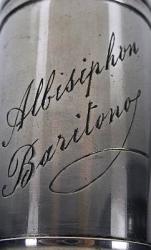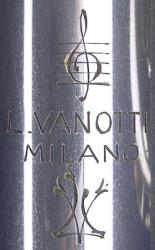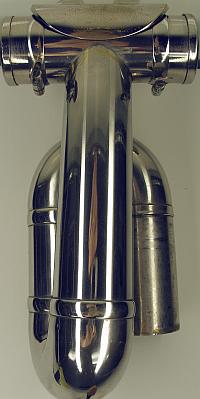
|
Essentially a standard
Boehm flute on steroids, the Albisiphon allowed
the player to manage its size by using a neck strap and playing it
vertically in front of the body like a clarinet. This was
accomplished by mounting the embouchure onto the end of a tube with a
slightly conical bore which
tapers in diameter throughout the run of a complete spiral before
meeting the receiver barrel of the main flute body. This kept the
player's arms in a reasonably comfortable position without need for an
inordinately intricate key mechanism.

To allow for the
proper distance from the blow hole to the crown cork
in a T-shaped headjoint, Albisi places two corks, one on each end of
the bar. (My fluid dynamics friend Masahiro Ishibashi informs me
that acoustically only one end needs to be use for third octave
correction, so perhaps the "T" shape was just aesthetically more
pleasing than the "L" shape.) I detect no taper across the bar
piece. This assembly is inserted into a split-cylinder atop the
tapering headjoint tube, which allows for some rotation of the
embouchure
plate to accommodate the player's preference. When assembled to
one's liking, two ring clamps are used to lock it into position and
seal the join, and crowns / end caps are spun into place. |

|
This
specimen has a single
normally closed G# tonehole on the back of the body opened with the G#
touch. The Albisiphon
in the Miller collection also has a single G# tonehole, but it is
inline with the main string of toneholes and operates from an outboard
longitudinal axle next to the long rod operating the low B. I freely
admit to being one of the most
wretched living Albisiphon players, but I detect no problem with this
configuration. With toneholes this size, leaving the G# closed
doesn't
appreciably muffle the sounding of A. |

|
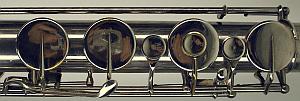 There
are a few other interesting observations about the
mechanism. The thumb keys are attached to a pinned longitudinal
rod, achieving the modern Briccialdi Bb action. The R1 shake
duplicates the L3 motion by closing the G key. The R3 touch
essentially duplicates the motion of L2 by closing the A key -- to what
purpose, I have no clue. There
are a few other interesting observations about the
mechanism. The thumb keys are attached to a pinned longitudinal
rod, achieving the modern Briccialdi Bb action. The R1 shake
duplicates the L3 motion by closing the G key. The R3 touch
essentially duplicates the motion of L2 by closing the A key -- to what
purpose, I have no clue. |
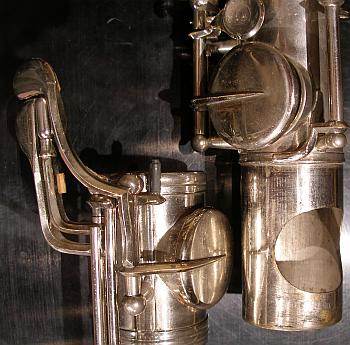
|
Note also the long foot
tenon perforated for the D# tonehole to accommodate the massive
B-footjoint. At left you can see the clutch between the L4 touch and
the low B key. When assembled, the L4 rod arm slides under the
footjoint coupling so that when L4 is pressed down, the coupling is
lifted and this motion in turn closes the low B. (There is no
duplicate touch in the R4 key cluster.)
I modified a
Winchester case for break-down shotguns to store and
transport
the Albisiphon. Now I can wear my camoeflage vest and take this
to a gig -- and
just DARE anyone
to heckle the flute player....
|
|

|


